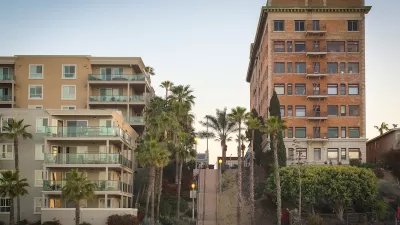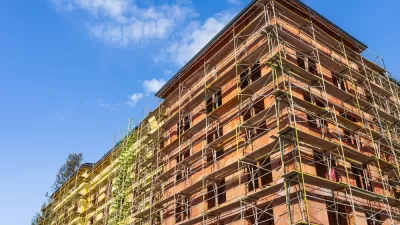The parallel crises of pollution and housing affordability require denser zoning of land uses, otherwise known as upzoning, according to this article.

Alex Baca writes for Greater Greater Washington to capture the current trend in upzoning, defined here as "changing zoning laws to make legal taller and/or denser buildings," as pursued by cities (Minneapolis and Seattle) and states (Oregon and California) as a way to address high housing costs.
After setting the context, Baca asks the key question: Why upzoning? The answer: on most of the land in the country, "all you can build is a single-family home, typically on a large lot." The Washington, D.C. region provides a perfect example of that kind of land use choice, according to Baca: "72% of our region is zoned single-family (this includes the Montgomery County Agricultural Reserve), while 42% of DC alone is zoned single-family."
The reason to reverse the dominant trend in the country, according to Baca is twofold: housing affordability and the environmental impact of sprawling land use patterns.
Neither of these parallel crises is helped by the fact that the only thing you can usually build in most American cities is a single-family home, which is on average more expensive than a home in a multiplex, and far worse for the environment. By preventing multifamily homes outright, single-family zoning dramatically curtails the construction of more, smaller homes. Apartment living might not be for everyone, but it shouldn’t be off-limits to build the kinds of neighborhoods we say we love.
FULL STORY: Why’s everyone talking about upzoning? It’s the foundation of green, equitable cities.

Alabama: Trump Terminates Settlements for Black Communities Harmed By Raw Sewage
Trump deemed the landmark civil rights agreement “illegal DEI and environmental justice policy.”

Planetizen Federal Action Tracker
A weekly monitor of how Trump’s orders and actions are impacting planners and planning in America.

The 120 Year Old Tiny Home Villages That Sheltered San Francisco’s Earthquake Refugees
More than a century ago, San Francisco mobilized to house thousands of residents displaced by the 1906 earthquake. Could their strategy offer a model for the present?

In Both Crashes and Crime, Public Transportation is Far Safer than Driving
Contrary to popular assumptions, public transportation has far lower crash and crime rates than automobile travel. For safer communities, improve and encourage transit travel.

Report: Zoning Reforms Should Complement Nashville’s Ambitious Transit Plan
Without reform, restrictive zoning codes will limit the impact of the city’s planned transit expansion and could exclude some of the residents who depend on transit the most.

Judge Orders Release of Frozen IRA, IIJA Funding
The decision is a victory for environmental groups who charged that freezing funds for critical infrastructure and disaster response programs caused “real and irreparable harm” to communities.
Urban Design for Planners 1: Software Tools
This six-course series explores essential urban design concepts using open source software and equips planners with the tools they need to participate fully in the urban design process.
Planning for Universal Design
Learn the tools for implementing Universal Design in planning regulations.
Clanton & Associates, Inc.
Jessamine County Fiscal Court
Institute for Housing and Urban Development Studies (IHS)
City of Grandview
Harvard GSD Executive Education
Toledo-Lucas County Plan Commissions
Salt Lake City
NYU Wagner Graduate School of Public Service





























